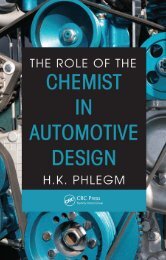Lightweight Electric/Hybrid Vehicle Design
Lightweight Electric/Hybrid Vehicle Design
Lightweight Electric/Hybrid Vehicle Design
You also want an ePaper? Increase the reach of your titles
YUMPU automatically turns print PDFs into web optimized ePapers that Google loves.
<strong>Design</strong> for optimum body-structural and running-gear performance efficiency 239<br />
Such metering is also essential for automatic braking and Adaptive Cruise Control (ACC).<br />
Current cruise control, it is argued, can suffer a lack of sufficient engine deceleration on steep<br />
gradients such that the vehicle gains speed; EAS can supply precisely metered braking pressure to<br />
prevent this. Beyond this, EAS can generate pressure for ACC so that a vehicle is kept at a safe<br />
distance from the one ahead, without having to rely on engine braking which might prove inadequate.<br />
For stage three the problem of varying brake pressure requirement with degree of vehicle payload<br />
is tackled. Here, not only is brake booster pressure metered but also the pressure level boosted<br />
proportionally to the pedal force (measured by piston rod sensor), so that constant deceleration is<br />
obtained with constant pedal force irrespective of payload.<br />
Brake-by-wire systems have now been developed which provide for not only a wired connection<br />
between pedal and brake actuator but also for electromagnetic actuation of the brake itself. The<br />
Delphi Chassis Galileo system allows dynamic brake effort apportioning, tunable pedal feel and<br />
variable boost ratio, without the need for hydraulic/vacuum assistance, as well as integration<br />
possibilities with stability enhancement systems. Potential exists for closed loop control of braking<br />
for front-to-rear and side-to-side braking balance; active independent wheel brake control allows<br />
ABS and ASR to interface with collision avoidance system, (a).<br />
‘Electrohydraulic apply’ is one variant of the system, shown at (b), in which closure of the stop<br />
lamp switch, as braking is applied, causes the ECU to close normally open solenoids. Upstream of<br />
these brake fluid pressure caused by the application is sensed and transducers emit a proportional<br />
signal to actuate piston-displacement motors on the front brakes. Pressure is continuously modulated<br />
by the size of this signal and the rear brakes applied proportionately to provide a balance dictated<br />
by a complex slip control algorithm. The ‘feel’ on the brake pedal is achieved by displacing fluid<br />
from the master cylinder into an emulator device which provides a predefined force/displacement<br />
characteristic tunable by the brake algorithm. If a fault is detected during powered (motor-actuated)<br />
braking, the solenoids switch to the open position so that unassisted direct braking is available.<br />
ABS and ASR is achieved by overriding the driver input with a control command based on wheel<br />
speed.<br />
The rear electric brake system (c) is intended for small weight-critical cars where removal of the<br />
park-brake cable assembly can save between 3 and 6 kg and works in conjunction with the brake<br />
system just described or a conventional hydraulic brake. The rear brake is a high-gain<br />
electromagnetic actuator designed to maximize torque capability with minimum electrical input.<br />
Closed-loop control ensures stability of the gain so that at an operating torque of 400 Nm, say,<br />
each wheel brake can respond at rates up to 4000 Nm/sec, to continually adjust dynamic brake<br />
output. The wheel brake incorporates a PM DC motor, gear train and ball-screw/nut mechanism,<br />
actuating the brake friction surfaces through a lever system. A ‘backdrive’ spring incorporates a<br />
park-brake latch mechanism. This is a bi-stable clutch device which locks the main motor shaft on<br />
demand. The park-brake holds until the switch deactivates, without electrical input. Closed loop<br />
control generally reduces the effect of component and operating condition variability on braking<br />
performance, algorithms based on differential wheel speed information compensate for load<br />
distribution variation.<br />
8.11.3 ELECTRONICALLY CONTROLLED CONTINUOUSLY VARIABLE TRANSMISSION<br />
While in series hybrid-drives batteries and IC engine typically power motor/generators, to drive<br />
the road wheels, in parallel configured, hybrid-electric/IC-engine drive vehicles there is mechanical<br />
drive between IC engine and road wheels, usually via continuously variable transmission, Fig.<br />
8.21. A widely accepted CVT is the variable-pitch pulley and belt-drive type originating in the<br />
Van Doorne design; this transmission heralded the steel drive belt having separate tension and







